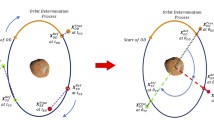Abstract
Unstable orbits about the collinear libration points require stationkeeping maneuvers to maintain the nominal path. A new method for stationkeeping such unstable orbits is proposed here using continuous thrust. The stationkeeping challenge is formulated as a nonlinear optimal control problem in the framework of the circular restricted three-body problem with the Sun and Earth/Moon center of mass as the two primaries. A recently developed control technique known as the “θ-D controller” is employed to provide a closed-form suboptimal feedback solution to this nonlinear control problem. In this approach an approximate solution to the Hamiltonian-Jacobi-Bellman (HJB) equation is found by adding perturbation terms to the cost function. The controller is designed such that the actual (numerically integrated) trajectory tracks a predetermined Lissajous reference orbit with good accuracy. Numerical results employing this method demonstrate the potential of this approach with stationkeeping costs varying between 0.52 ∼ 0.68 m/s per year (the range depending on the particular simulation parameters used), which is of the same order of magnitude as other methods using discrete maneuvers with halo orbits. The costs are modest and the method provides flexibility in selecting the “tightness” of the control versus fuel consumption. The algorithm is well-suited for integration with onboard flight software, as the nonlinear optimal control law is solved in closed-form and the Riccati equation must only be solved once, resulting in a computationally efficient controller.
Similar content being viewed by others
References
FARQUHAR, R.W. “The Flight of ISEE-3/ICE: Origins, Mission History, and a Legacy,” The Journal of the Astronautical Sciences, Vol. 49, No. 1, 2001, pp. 23–73.
FARQUHAR, R.W. “The Control and Use of Libration-Point Satellites,” NASA TR R-346, September 1970.
BREAKWELL, J.V., KAMEL, A. A., and RATNER, M. J. “Stationkeeping for a Translunar Communication Station,” Celestial Mechanics, Vol. 10, No. 3, 1974, pp. 357–373.
SIMO, C., GOMEZ, G., LLIBRE, J., and MARTINEZ, R. “Stationkeeping of a Quasiperiodic Halo Orbit Using Invariant Manifolds,” Proceedings of the Second International Symposium on Spacecraft Flight Dynamics, Darmstadt, Germany, Oct. 1986, pp. 65–70.
HOWELL, K. C. and PERNICKA, H. J. “Stationkeeping Method for Libration Point Trajectories,” Journal of Guidance, Control and Dynamics, Vol. 16, No. 1, 1993, pp. 151–157.
DWIVEDI, N. P. “Deterministic Optimal Maneuver Strategy for Multi-Target Missions,” Journal of Optimization Theory and Applications, Vol. 17, Nos. 1/2, 1975, pp. 133–153.
CIELASZYK, D. and WIE, B. “New Approach to Halo Orbit Determination and Control,” Journal of Guidance, Control and Dynamics, Vol. 19, No. 2, 1996, pp. 266–273.
DUNHAM, D.W. and ROBERTS, C. E. “Stationkeeping Techniques for Libration-Point Satellites,” The Journal of the Astronautical Sciences, Vol. 49, No. 1, 2001, pp. 127–144.
RAHMANI, A., JALALI, M. A., POURTAKDOUST, S.H. “Optimal Approach to Halo Orbit Control,” presented as paper AIAA 2003-5748 at the AIAA Guidance, Navigation, and Control Conference and Exhibit, Austin, Texas, Aug. 11–14, 2003.
HOWELL, K. C. and PERNICKA, H. J. “Numerical Determination of Lissajous Trajectories in the Restricted Three-Body Problem,” Celestial Mechanics, Vol. 41, pp. 107–124, 1988.
CLOUTIER, J. R. and STANSBERY, D. T. “The Capabilities and Art of State-Dependent Riccati Equation-Based Design,” Proceedings of the American Control Conference, The American Automatic Control Council, IEEE, Piscataway, NJ. Vol. 5, 2001, pp. 3352–3357.
BRYSON, Jr., A. E. and HO, Y-C. Applied Optimal Control, Hemisphere Publishing Corporation, 1975.
XIN, M. and BALAKRISHNAN, S.N. “A New Method for Suboptimal Control of a Class of Nonlinear Systems,” Optimal Control Applications and Methods, Vol. 26, No. 2, 2005, pp. 55–83.
XIN, M., BALAKRISHNAN, S.N., STANSBERY, D. T., and OHLMEYER, E. J. “Nonlinear Missile Autopilot Design with Theta-D Technique,” AIAA Journal of Guidance, Control and Dynamics, Vol. 27, No. 3, 2004, pp. 406–417.
DRAKE, D., XIN, M., and BALAKRISHNAN, S.N. “A New Nonlinear Control Technique for Ascent Phase of Reusable Launch Vehicles,” AIAA Journal of Guidance, Control and Dynamics, Vol. 27, No. 6, 2004.
XIN, M., BALAKRISHNAN, S.N., and OHLMEYER, E. J. “Integrated Guidance and Control of Missiles with Theta-D Method,” IEEE Transactions on Control Systems Technology, Vol. 14, No. 6, pp. 981–992, 2006.
Author information
Authors and Affiliations
Corresponding author
Rights and permissions
About this article
Cite this article
Xin, M., Balakrishnan, S.N. & Pernicka, H.J. Libration point stationkeeping using the θ-D technique. J of Astronaut Sci 56, 231–250 (2008). https://doi.org/10.1007/BF03256550
Published:
Issue Date:
DOI: https://doi.org/10.1007/BF03256550




